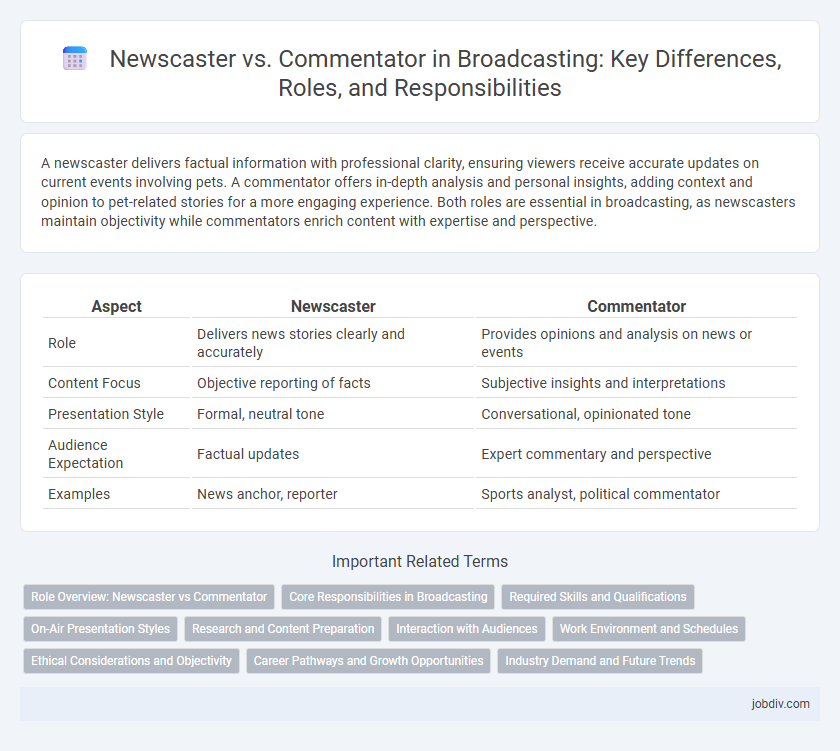A newscaster delivers factual information with professional clarity, ensuring viewers receive accurate updates on current events involving pets. A commentator offers in-depth analysis and personal insights, adding context and opinion to pet-related stories for a more engaging experience. Both roles are essential in broadcasting, as newscasters maintain objectivity while commentators enrich content with expertise and perspective.
Table of Comparison
| Aspect | Newscaster | Commentator |
|---|---|---|
| Role | Delivers news stories clearly and accurately | Provides opinions and analysis on news or events |
| Content Focus | Objective reporting of facts | Subjective insights and interpretations |
| Presentation Style | Formal, neutral tone | Conversational, opinionated tone |
| Audience Expectation | Factual updates | Expert commentary and perspective |
| Examples | News anchor, reporter | Sports analyst, political commentator |
Role Overview: Newscaster vs Commentator
Newscasters deliver factual news reports by presenting verified information clearly and objectively to the audience. Commentators provide analysis and personal opinions, offering context and interpretation on current events or topics. While newscasters prioritize unbiased reporting, commentators emphasize subjective viewpoints to engage viewers in deeper discussions.
Core Responsibilities in Broadcasting
Newscasters deliver timely, accurate news reports by reading scripts and presenting live updates to viewers, ensuring clarity and credibility in broadcast journalism. Commentators provide expert analysis and interpretation of news events, offering opinions and context that deepen audience understanding of complex issues. Both roles demand strong communication skills but differ in purpose: newscasters focus on objective reporting, while commentators emphasize subjective insights.
Required Skills and Qualifications
Newscasters require strong communication skills, a clear and engaging voice, and the ability to deliver news accurately under tight deadlines, often holding degrees in journalism or communications. Commentators must possess in-depth knowledge of their specialized subject, critical thinking abilities, and a talent for providing insightful analysis, frequently backed by experience in the field they cover. Both roles demand excellent research skills and the capability to connect with diverse audiences while maintaining credibility and professionalism on air.
On-Air Presentation Styles
Newscasters maintain a neutral, objective tone, delivering headlines and facts with concise clarity to ensure accurate information dissemination. Commentators adopt a more conversational and expressive style, offering analysis, personal insights, and opinions that engage viewers critically. Both roles use vocal modulation, pacing, and body language distinctively to suit their specific broadcast purposes and audience expectations.
Research and Content Preparation
Newscasters prioritize delivering verified facts directly from official sources, focusing on clarity and timeliness in news reporting. Commentators engage in in-depth research to provide analysis and expert opinions, synthesizing information from multiple perspectives to offer context. Content preparation for newscasters involves script reading and live updates, whereas commentators require comprehensive background study and critical interpretation of events.
Interaction with Audiences
Newscasters deliver news with clear, objective reporting, maintaining a professional distance to ensure credibility and trustworthiness, which fosters a one-way flow of information to audiences. Commentators engage audiences through subjective analysis and opinion, often encouraging interaction via social media or live discussions, creating a dynamic and participatory experience. This interactive approach enhances audience engagement and builds stronger connections by inviting viewers to respond, debate, and share perspectives.
Work Environment and Schedules
Newscasters typically work in highly structured environments such as television studios, adhering to strict broadcast schedules that demand early mornings, late nights, or weekend shifts to deliver timely news updates. Commentators often have more flexible work settings, including live events or remote locations, allowing variable hours tailored to specific programs or sporting events. The differing schedules impact their work-life balance, with newscasters facing routine deadlines while commentators adjust to sporadic, event-driven timetables.
Ethical Considerations and Objectivity
Newscasters are expected to present factual information impartially, adhering to strict ethical standards that prioritize accuracy and neutrality to maintain audience trust. Commentators, while often providing analysis and opinion, must clearly differentiate between objective facts and personal viewpoints to uphold transparency and credibility. Both roles require careful navigation of bias to ensure ethical broadcasting and preserve the integrity of the information shared with viewers.
Career Pathways and Growth Opportunities
Newscasters typically begin their careers in local news stations, gaining experience in reporting and anchoring before advancing to national networks or specialized segments, with growth opportunities including lead anchor roles and newsroom management. Commentators often start as experts or journalists in specific fields, building reputations through opinion pieces, panel discussions, and digital platforms, leading to careers in syndicated shows, political analysis, or media consultancy. Both career pathways require strong communication skills and adaptability, but commentators tend to have more flexibility in subject matter expertise, while newscasters focus on delivering objective news content.
Industry Demand and Future Trends
The broadcasting industry shows a growing demand for newscasters skilled in multimedia storytelling and digital platforms, reflecting the audience's preference for real-time, accurate information delivery. Commentators are increasingly valued for expertise in niche topics and engaging analysis, enhancing viewer retention through in-depth perspectives. Future trends indicate a blend of AI-driven content support and immersive technologies will shape roles, emphasizing adaptability and specialized knowledge in both newscasting and commentary.
Newscaster vs Commentator Infographic

 jobdiv.com
jobdiv.com